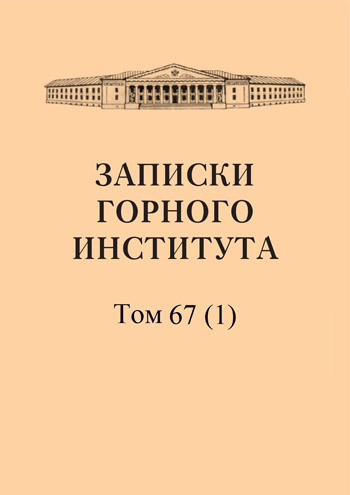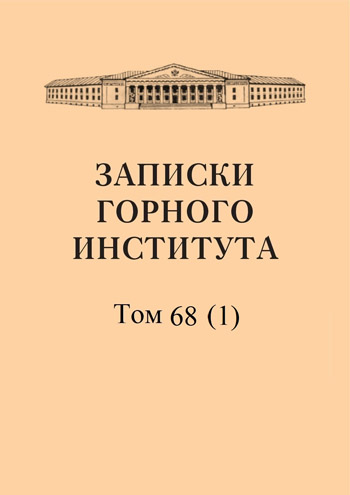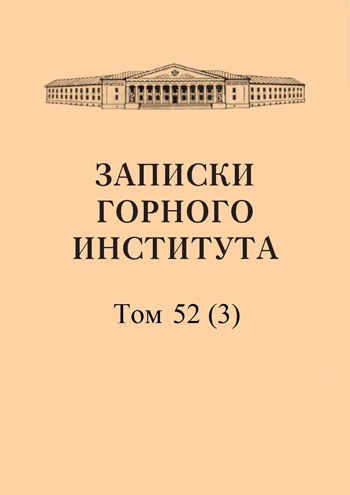-
Date submitted1974-07-05
-
Date accepted1974-09-21
-
Date published1975-01-01
Problems of physical and chemical processes of mining production
- Authors:
- V. V. Rzhevsky
- A. P. Dmitriev
The program of the CPSU to build communism in the USSR provides for the further development of the raw material base of modern industry. ...
-
Date submitted1974-07-04
-
Date accepted1974-09-13
-
Date published1975-01-01
Problems of development of mining physics and subsurface mechanics (mechanics of rocks and massifs)
- Authors:
- A. A. Borisov
Among the most important problems of our time prominent place is occupied by the problems of subsurface mechanics, on the solution of which are working scientists of the largest countries in the world. ...
-
Date submitted1974-07-05
-
Date accepted1974-09-28
-
Date published1975-01-01
Topical problems of mining thermophysics
- Authors:
- Yu. D. Dyadkin
At the present stage of scientific and technological progress, the Earth's subsoil is more and more fully involved in the sphere of social production, the role of mining science is increasing, the range of its problems is expanding. ...
-
Date submitted1974-07-11
-
Date accepted1974-09-14
-
Date published1975-01-01
Prospects of mine aerology development for the nearest decades
- Authors:
- P. I. Mustel
Mine aerology as one of the sections of mining science is developing in strict accordance with the progress in the field of technology and technique of mining, and, since in some cases the issues of aerology and technology are interrelated, changes in the technological process will require new solutions in the field of aerology. ...
-
Date submitted1974-07-12
-
Date accepted1974-09-14
-
Date published1975-01-01
Current state and prospects of development of electrothermomechanical destruction of frozen rocks
- Authors:
- Yu. M. Misnik
- L. B. Nekrasov
The most characteristic feature of frozen rock mining is its high energy intensity and cost. Ice cemented loose rocks at low subzero temperatures become so strong that their excavation without preliminary preparation turns out to be ineffective. ...
-
Date submitted1974-07-23
-
Date accepted1974-09-28
-
Date published1975-01-01
Physical prerequisites of transition to flow technology of rock fracturing in hard rocks
- Authors:
- A. N. Khanukaev
Achieved successes in the technique and technology of development of mineral deposits have created the necessary prerequisites for the transition to the stream, more progressive technology of mining operations in strong rocks. ...
-
Date submitted1974-07-21
-
Date accepted1974-09-05
-
Date published1975-01-01
Energy intensity of rock destruction
- Authors:
- V. A. Padukov
Destruction (crushing) of rocky rocks - the process of formation of new surfaces, the formation of pieces, each of which, according to the Curie principle, has two types of energy - volume energy and surface energy. ...
-
Date submitted1974-07-04
-
Date accepted1974-09-02
-
Date published1975-01-01
Investigation and prediction of mechanical action of camouflage explosions
- Authors:
- G. G. Yurevich
In recent years, mining science has paid much attention to the problem of utilizing the explosion energy of powerful charges. Destruction of large volumes of ore, open mining, construction of underground oil and gas reservoirs, extraction of metal ores and salts by underground leaching, creation of underground thermal boilers - this is not a complete list of possible applications of underground nuclear explosions for peaceful purposes. ...
-
Date submitted1974-07-18
-
Date accepted1974-09-25
-
Date published1975-01-01
Prospects of the Earth heat extraction by means of deep drilling and methodology of its economic efficiency estimation
- Authors:
- Yu. M. Pariysky
Modern scientific and technological progress requires more and more complete development and rational use of natural resources. Along with the use of other types of energy and fuel, geothermal resources are an important energy reserve. With the development of science and technology, the possibilities of extracting the deep heat of the Earth are expanding. ...
-
Date submitted1974-07-17
-
Date accepted1974-09-30
-
Date published1975-01-01
Theory and methods of regulating the temperature regime of ultra-deep wells
- Authors:
- B. B. Kudryashov
With the increase of drilling depths at present up to 6-7 thousand meters, and in the foreseeable future up to 10-15 thousand meters, the temperature factor becomes more and more serious. ...
-
Date submitted1974-07-03
-
Date accepted1974-09-12
-
Date published1975-01-01
Strength criteria and stress diagrams of rocks
- Authors:
- L. S. Burshteyn
- A. N. Kurochkin
In the general complex of questions on the destruction of rocks an important place is occupied by the development of the theory of strength and improvement of methods of their testing. As a result of this research, new ideas about the properties of rocks and the mechanism of their fracture have emerged. This article deals with the matter of the relationship between the theory of strength and the mechanism of fracture and provides methods of constructing stress diagrams and their interpretation. ...
-
Date submitted1974-07-20
-
Date accepted1974-09-30
-
Date published1975-01-01
Application of radio electronics in mining
- Authors:
- A. L. Drabkin
- V. V. Maslennikova
Our time is characterized by rapid development of radio electronics and its wide penetration into various branches of national economy. Radio methods are successfully used in the search for minerals, in geophysical research, in surveying (radio dial gauges and laser directional indicators), begins the introduction of radio electronics and at mining enterprises too. ...
-
Date submitted1974-07-30
-
Date accepted1974-09-26
-
Date published1975-01-01
Laser technology in mining
- Authors:
- E. I. Golovanevsky
- V. N. Charnetsky
Electronics penetrating into all areas of technology in the last decade is growing and developing on the basis of the use of synthesized crystals and minerals, which especially applies to the newest direction of this field - laser technology. ...
-
Date submitted1974-07-01
-
Date accepted1974-09-06
-
Date published1975-01-01
Forecasting in mining industry
- Authors:
- N. V. Melnikov
Information accumulated in the forecasting of scientific and technical progress of the mining industry, directly affects the modern operational management of mining production. ...
-
Date submitted1974-07-04
-
Date accepted1974-09-14
-
Date published1975-01-01
Automated control systems of mining enterprises
- Authors:
- A. D. Shkolnikov
The enlargement of enterprises, strengthening of links between them, improvement of planning methods leads to the need to process significant flows of technical and economic information used to solve the problems of production management. ...
-
Date submitted1974-07-16
-
Date accepted1974-09-22
-
Date published1975-01-01
Creating mines of the future
- Authors:
- N. K. Grinko
In the age of scientific and technological revolution for each branch of industry should be determined ways of transition in the future to a qualitatively new technical and economic level of production. For this purpose it is already now necessary to answer the question, what will be our enterprises in 1985-1990. ...
-
Date submitted1974-07-08
-
Date accepted1974-09-08
-
Date published1975-01-01
Ways of technical progress in the development of potash deposits of the USSR
- Authors:
- K. D. Vasin
- R. S. Permyakov
The USSR is one of the world's leading producers of potash fertilizers. The volume of potash ore production is currently about 42 million tons, by 1975 it will reach 60 million tons, and by 1980 - 85 million tons. ...
-
Date submitted1974-07-21
-
Date accepted1974-09-01
-
Date published1975-01-01
Some problems of potash mines aerology
- Authors:
- I. I. Medvedev
In the last decade, the USSR has implemented an extensive program of reconstruction of existing potash mines and construction of new potash mines, which has brought our country to the first place in the world in terms of potash fertilizer production. ...
-
Date submitted1974-07-23
-
Date accepted1974-09-11
-
Date published1975-01-01
Some results of scientific researches at shale mines of the Leningrad region
- Authors:
- G. P. Bakinov
Oil shale mines of the Leningrad region are characterized by a complex structural structure of the promplast of the working capacity of 1.5-1.6 m (including three layers of oil shale with a total thickness of 1.0-1.05 m and two interlayers of limestone), low thickness of individual layers of oil shale, significant karst in the host rock strata, high inflows of groundwater, etc. ...
-
Date submitted1974-07-20
-
Date accepted1974-09-23
-
Date published1975-01-01
Strengthening of preparatory workings in coal mines
- Authors:
- B. V. Bokiy
- V. V. Smirnyakov
Maintaining preparatory workings in good condition is one of the conditions determining the normal development of cleaning works. ...
-
Date submitted1974-07-30
-
Date accepted1974-09-20
-
Date published1975-01-01
Ways of providing stability of mine workings
- Authors:
- O. V. Timofeev
Under the stability of mine workings is understood the preservation within a given period of time the required size and shape of its cross-section in accordance with the requirements of the rules of technical operation and safety. ...
-
Date submitted1974-07-01
-
Date accepted1974-09-30
-
Date published1975-01-01
Stability of the rocks surrounding the mine workings and the choice of the type of support
- Authors:
- N. S. Bulychev
Under the stability of rocks is understood their property to form stable outcrops during the sinking of mine workings. Stable is considered to be such a state of the exposed unfastened section of the rock massif, in which during the necessary period of time under the conditions of production rocks do not collapse and do not slide, and the exposed surface or its part is displaced within the permissible limits. ...
-
Date submitted1974-07-02
-
Date accepted1974-09-30
-
Date published1975-01-01
Improvement of the system of development of thick hollow seams by inclined layers
- Authors:
- E. Ya. Makhno
Strong gentle strata in the USSR and abroad are developed mainly by inclined layers with roof collapse. In this system of development rack fasteners in cleaning faces allows to lay in each upper layer of wooden planking or metal mesh, which eliminates coal losses in the thickness of the seam and provides high completeness of excavation. But the use of rack support requires significant costs, heavy manual labor and reduces the production capabilities of the system, which in this form can not meet the requirements of the current period. ...
-
Date submitted1974-07-10
-
Date accepted1974-09-28
-
Date published1975-01-01
Basics of the method of optimization of the parameters of the floor forced caving system
- Authors:
- N. Z. Galaev
The system of floor forced caving is widely used in the development of powerful, vast deposits. Representing a complex complex of mutually influencing and conditioning each other parameters and processes, in their compliance with mining geological and mining conditions, this system provides high labor productivity and low cost of ore extraction. ...
-
Date submitted1974-07-11
-
Date accepted1974-09-22
-
Date published1975-01-01
Direction and intensity of mining development in the open-pit field
- Authors:
- A. I. Arsentev
Solid minerals are extracted by three methods: underground, surface (open pit) and underwater. The first two methods are widely developed, the third is beginning to develop.When designing and planning the development of a deposit, it is necessary to take into account the main features of mining methods. All factors affecting the efficiency of work are useful to categorize into two parts: objective and subjective. ...
-
Date submitted1974-07-24
-
Date accepted1974-09-24
-
Date published1975-01-01
Economic limits of service life of mining transportation equipment of the quarries of the Far North
- Authors:
- O. B. Bokiy
- L. E. Kamenetsky
Open-pit mining in the USSR is continuously growing. In 1975, open-pit coal production compared to 1970 will increase by 52.2-55.2 million tons and will amount to 205.5-208.5 million tons, or 30% of the total coal production in the country. In 1980 and 2000, the share of surface coal mining will be respectively 40-45 and about 70% of the total coal production in the USSR. ...
-
Date submitted1974-07-28
-
Date accepted1974-09-23
-
Date published1975-01-01
Modern state and main directions of improvement of economic analysis
- Authors:
- G. G. Bro
The problems of economic analysis in the coal industry began to be developed in 1921-1927. To this time belong works, which not only investigated the relevance of this or that indicator, but also carefully developed the methodology of analysis of labor productivity, cost and profitability. In these and subsequent years, the beginning of technical and economic analysis of the cost of production and labor productivity was laid. ...
-
Date submitted1974-07-08
-
Date accepted1974-09-14
-
Date published1975-01-01
Scientific and technical revolution and mining economics
- Authors:
- Yu. V. Yakovets
Developing now in the world scientific and technological revolution leads to the breakdown of established proportions and methods of production, generates new, sometimes contradictory phenomena and trends in the economic life of society. This process has affected one of the oldest industrial branches of human activity - mining. ...
-
Date submitted1974-07-16
-
Date accepted1974-09-29
-
Date published1975-01-01
Peculiarities of the methodology of determination of losses taking into account the overflow of substandard ores at the system of storey forced caving
- Authors:
- I. N. Ushakov
- S. P. Pavlov
- V. S. Kozhin
At the mines of Apatit Combine, using a system of storey forced caving, in the blocks mined under the previously extinguished horizons, the definition of ore losses is complicated due to the transfer of beaten substandard ore and losses from the upper blocks. ...
-
Date submitted1974-07-23
-
Date accepted1974-09-11
-
Date published1975-01-01
Autoreduction optical plummet with liquid lens
- Authors:
- N. A. Gusev
Modern optical theodolites are usually equipped with optical plumb bobs located on the alidade part or on the stand, which are used to center the theodolite over the top of the measured horizontal angle. ...
-
Date submitted1974-07-06
-
Date accepted1974-09-01
-
Date published1975-01-01
Autoreduction liquid and spring compensators and their application in surveying and geodetic devices
- Authors:
- N. A. Gusev
Autoreduction compensators last 10-15 years are used in many surveying and geodetic devices of new designs. They significantly improve the technology of surveying and measuring works, increase labor productivity and accuracy. ...
-
Date submitted1974-07-20
-
Date accepted1974-09-28
-
Date published1975-01-01
The future of surveying and geodetic networks
- Authors:
- K. A. Zvonarev
Surface and underground works need geodetic support, which is achieved by a network of properly located, fixed points on the ground, with the required accuracy defined in some systems of plan coordinates and elevations. ...
-
Date submitted1974-07-23
-
Date accepted1974-09-18
-
Date published1975-01-01
Traction devices with smooth driving wheels and prospects of their application in mining industry
- Authors:
- V. S. Bersenev
The positive properties of the smooth driving wheel used as a driving device of self-propelled carts are proved by the long-term operation of modern locomotives in various industries. The smooth wheel is very technologically advanced, capable of supporting significant normal, tangential and axial loads. ...
-
Date submitted1974-07-26
-
Date accepted1974-09-05
-
Date published1975-01-01
Optimal modes and reliability of hydrotransportation plants operation
- Authors:
- V. N. Pokrovskaya
- Yu. P. Boytsov
Hydraulic transportation of solid material is one of the important elements of the technological process of mining and processing of minerals. At present, the total length of hydraulic transportation lines in the USSR is more than 3 million km, and the volume of transported material - more than 300 million tons. ...
-
Date submitted1974-07-30
-
Date accepted1974-09-02
-
Date published1975-01-01
Rational method of mining harvester operation
- Authors:
- M. D. Kolomiytsov
Technical and economic indicators of mines increasingly depend on the efficiency and reliability of mining combines. The operation of mechanized complexes, and thus the mine as a whole, depends on the combine harvester productivity. The capacity of narrow-capture harvesters is continuously increasing, but their productivity is growing insufficiently, and the accident rate remains high. ...
-
Date submitted1974-07-13
-
Date accepted1974-09-22
-
Date published1975-01-01
Ways to improve the work of mine fans, drainage and pneumatic installations
- Authors:
- S. S. Smorodin
The performance of a mine plant in transporting fluids through pipelines using machines is determined by both the individual characteristic of the machine itself and the characteristic of the external network. The individual machine characteristic reflects the internal qualities of the machine and indicates how much useful work it can transfer to the external network. ...
-
Date submitted1974-07-03
-
Date accepted1974-09-13
-
Date published1975-01-01
Determination of reliability indices of duplicated circuits of power supply systems
- Authors:
- V. P. Muravev
- A. A. Fedorov
A duplicated system comprises two identical circuits, each designed for full load, with the changeover to standby power provided automatically. A sectionalizer, when one of the circuits is damaged, automatically connects the consumer to the serviceable circuit. ...
-
Date submitted1974-07-07
-
Date accepted1974-09-01
-
Date published1975-01-01
Method of sequential correction in the control systems of excavator drives
- Authors:
- V. V. Rudakov
Reduction of control power, characteristic for modern systems with static converters, has opened wide possibilities for realization of optimum control laws and increase of productivity and economy of excavators. ...
-
Date submitted1974-07-24
-
Date accepted1974-09-26
-
Date published1975-01-01
Automatic control of the rock mass weight in the dump trucks
- Authors:
- E. S. Krichevsky
- V. A. Gardzish
At open-pit mining method for transportation of rock mass at open pits of any productivity in recent years road transport is widely used, in particular, heavy-duty dump trucks. Dump trucks BelAZ-540, BelAZ-548A with carrying capacity, respectively, 27 and 40 tons are operated in conjunction with powerful excavators, have great maneuverability, good operational and speed qualities, low requirement for the profile of roads and 2-3 times increase the productivity of transport work in quarries. ...
-
Date submitted1974-07-08
-
Date accepted1974-09-07
-
Date published1975-01-01
Prospects of application of linear electric motors in mine transportation
- Authors:
- A. V. Rysev
- A. F. Boroznets
Linear electric motors are applicable in mine electric locomotive rolling, their introduction on monorail roads is a significant step forward in the technical progress of transportation. This achieves high efficiency, high power per unit weight, simplicity of construction, which facilitates repair and maintenance in operation, provides traction on steep ascents, eliminates noise and vibration during operation, there is no contact between moving parts. ...


